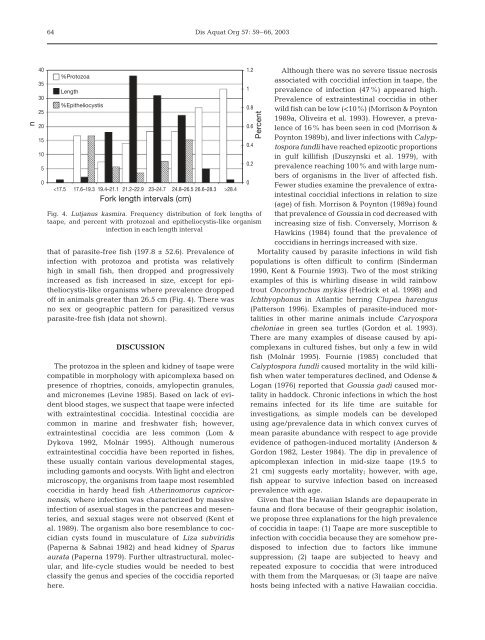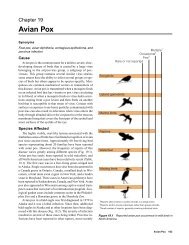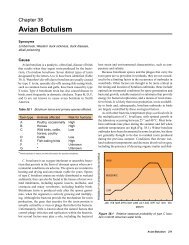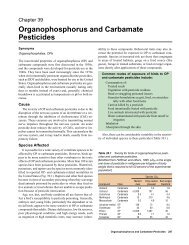Protozoal and epitheliocystis-like infections in the introduced
Protozoal and epitheliocystis-like infections in the introduced
Protozoal and epitheliocystis-like infections in the introduced
You also want an ePaper? Increase the reach of your titles
YUMPU automatically turns print PDFs into web optimized ePapers that Google loves.
64<br />
Dis Aquat Org 57: 59–66, 2003<br />
n<br />
40<br />
35<br />
30<br />
25<br />
20<br />
15<br />
10<br />
5<br />
0<br />
%Protozoa<br />
Length<br />
%Epi<strong>the</strong>liocystis<br />
28.4<br />
Fork length <strong>in</strong>tervals (cm)<br />
that of parasite-free fish (197.8 ± 52.6). Prevalence of<br />
<strong>in</strong>fection with protozoa <strong>and</strong> protista was relatively<br />
high <strong>in</strong> small fish, <strong>the</strong>n dropped <strong>and</strong> progressively<br />
<strong>in</strong>creased as fish <strong>in</strong>creased <strong>in</strong> size, except for <strong>epi<strong>the</strong>liocystis</strong>-<strong>like</strong><br />
organisms where prevalence dropped<br />
off <strong>in</strong> animals greater than 26.5 cm (Fig. 4). There was<br />
no sex or geographic pattern for parasitized versus<br />
parasite-free fish (data not shown).<br />
DISCUSSION<br />
The protozoa <strong>in</strong> <strong>the</strong> spleen <strong>and</strong> kidney of taape were<br />
compatible <strong>in</strong> morphology with apicomplexa based on<br />
presence of rhoptries, conoids, amylopect<strong>in</strong> granules,<br />
<strong>and</strong> micronemes (Lev<strong>in</strong>e 1985). Based on lack of evident<br />
blood stages, we suspect that taape were <strong>in</strong>fected<br />
with extra<strong>in</strong>test<strong>in</strong>al coccidia. Intest<strong>in</strong>al coccidia are<br />
common <strong>in</strong> mar<strong>in</strong>e <strong>and</strong> freshwater fish; however,<br />
extra<strong>in</strong>test<strong>in</strong>al coccidia are less common (Lom &<br />
Dykova 1992, Molnár 1995). Although numerous<br />
extra<strong>in</strong>test<strong>in</strong>al coccidia have been reported <strong>in</strong> fishes,<br />
<strong>the</strong>se usually conta<strong>in</strong> various developmental stages,<br />
<strong>in</strong>clud<strong>in</strong>g gamonts <strong>and</strong> oocysts. With light <strong>and</strong> electron<br />
microscopy, <strong>the</strong> organisms from taape most resembled<br />
coccidia <strong>in</strong> hardy head fish A<strong>the</strong>r<strong>in</strong>omorus capricornensis,<br />
where <strong>in</strong>fection was characterized by massive<br />
<strong>in</strong>fection of asexual stages <strong>in</strong> <strong>the</strong> pancreas <strong>and</strong> mesenteries,<br />
<strong>and</strong> sexual stages were not observed (Kent et<br />
al. 1989). The organism also bore resemblance to coccidian<br />
cysts found <strong>in</strong> musculature of Liza subviridis<br />
(Paperna & Sabnai 1982) <strong>and</strong> head kidney of Sparus<br />
aurata (Paperna 1979). Fur<strong>the</strong>r ultrastructural, molecular,<br />
<strong>and</strong> life-cycle studies would be needed to best<br />
classify <strong>the</strong> genus <strong>and</strong> species of <strong>the</strong> coccidia reported<br />
here.<br />
1.2<br />
1<br />
0.8<br />
0.6<br />
0.4<br />
0.2<br />
0<br />
Although <strong>the</strong>re was no severe tissue necrosis<br />
associated with coccidial <strong>in</strong>fection <strong>in</strong> taape, <strong>the</strong><br />
prevalence of <strong>in</strong>fection (47%) appeared high.<br />
Prevalence of extra<strong>in</strong>test<strong>in</strong>al coccidia <strong>in</strong> o<strong>the</strong>r<br />
wild fish can be low (
















